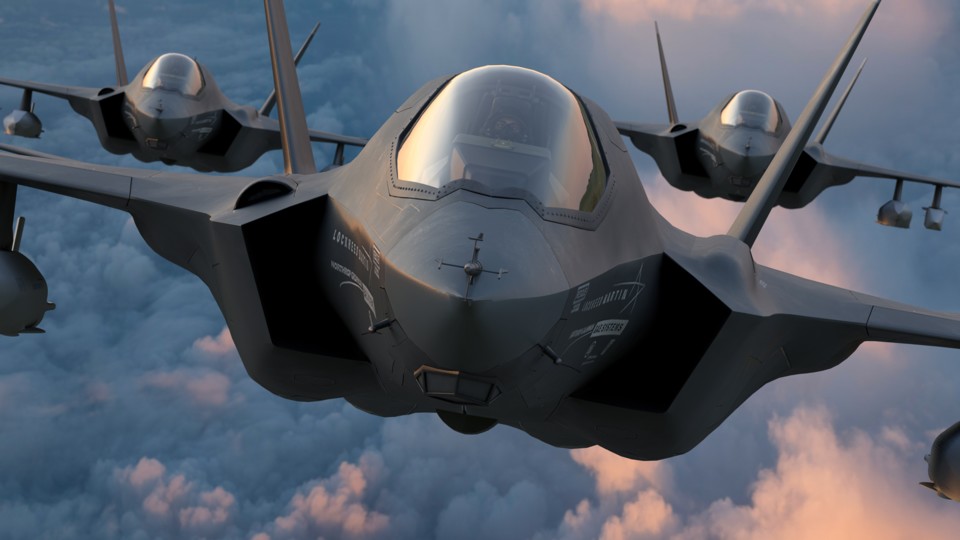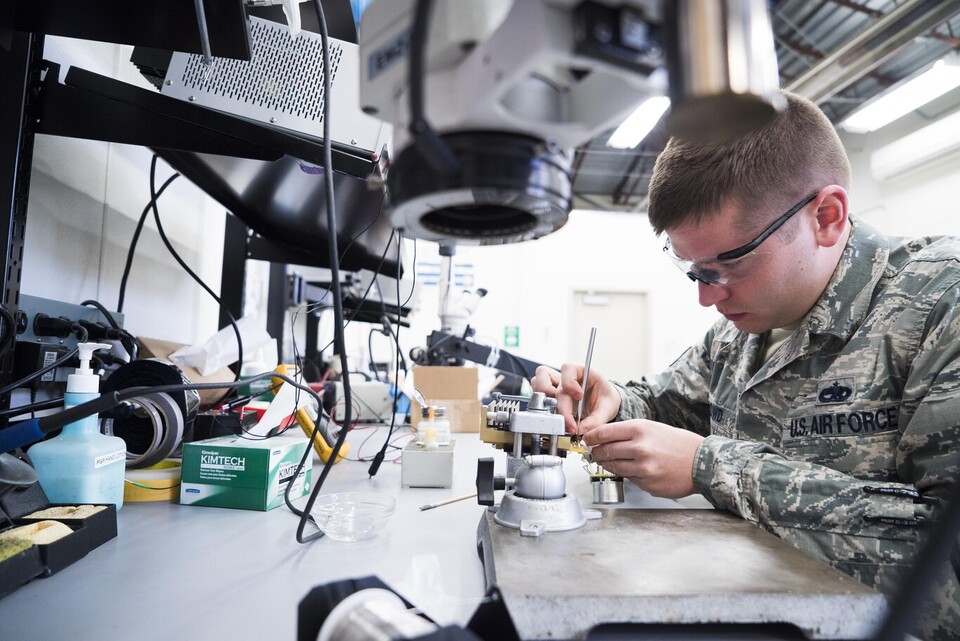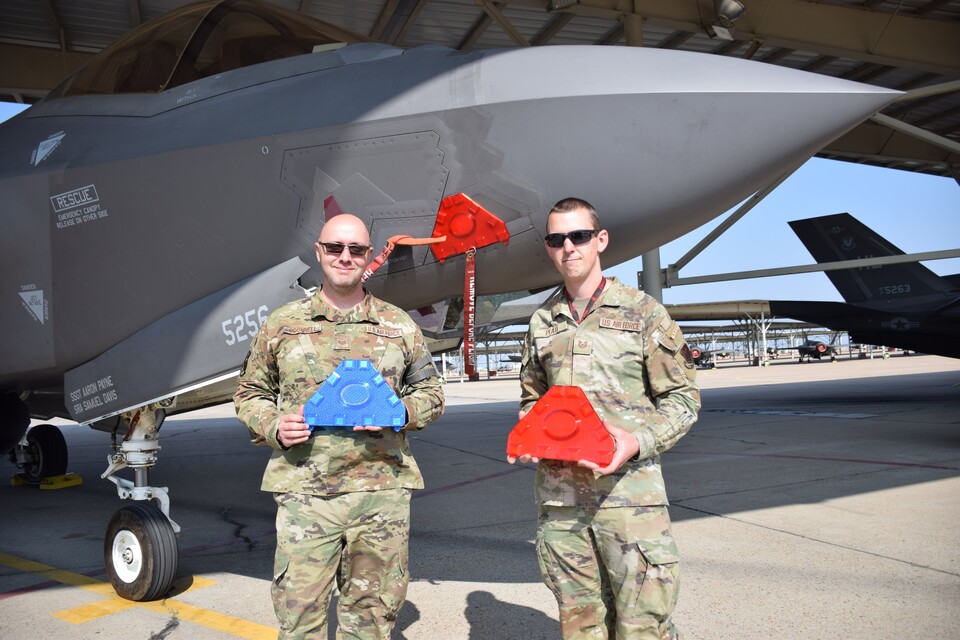
Fast, dangerous and expensive. When this special repair unit puts its hands on the high-end F-35 fighter plane, mere mortals can only marvel. (Image source: Mike Mareen via Adobe Stock)
»The most expensive solution is not always the best. Sometimes a simple and uncomplicated solution offers the silver bullet,” writes Carlos Prego. The editor looked at the Air Force Repair Improvement Program. This program is a rarely lauded team in the US Army, but one that is arguably one of “the most profitable” branches of the US armed forces , as Prego writes (Xataka via Air & Space Forces Magazine).
A visit to the repair shop
The girls and boys in the program don’t build planes. To do this, they repair devices that others say: “This junk is irrevocably broken and not worth repairing.”
The editor ventures a look into the workshops of the program. There he meets resourceful inventors. The experts put their heads together to find better and better approaches to repair (parts of) devices. Many of the gadgets that end up on Engineers’ workbenches are either extremely rare or seriously outdated. In both cases, tracking down suitable spare parts is extremely expensive or extremely difficult.
A current repair project of the “Air Force Repair Improvement Program” is particularly impressive.

Pictured: A technician from the repair team at work. (Image source: Xataka)
The $20,000 PSU: The scene is a US Air Force base in the US state of Idaho. The year is 2017, and those responsible at Mountain Home Air Force Base have come to terms with the fact that they would have to throw away a $20,000 power adapter.
Just throw away such a high-priced power supply? It was at this point that the Repair Improvement Program team made one of their appearances. The technicians examine the power supply in detail, advise each other – and finally exchanged a resistor. A resistor that costs just five US dollars to buy. The repair is a success.
What reads like child’s play was associated with many challenging tasks for the responsible technician Sergeant Zachary Dowd. Locate the power supply schematic. Relying on hand-drawn sketches of the power supply. Test each element of the power supply. Call the power supply manufacturer. Dowd went through all these steps until he finally isolated the problem – and his efforts were crowned with success.
To appreciate the achievements of a Zachary Dowd, the Air Force makes an everyday comparison. According to the, a repair campaign like the Dowds is comparable to a broken smartphone. A broken smartphone that someone fixes for you with a paper clip, so to speak – and then charges a slim cent amount for their excellent job. In other words: The work of the “Air Force Repair Improvement Program” is very cost-conscious and resource-saving.

Sergeant Christopher O’Donnell (left) and Sergeant Justin Platt pose with the 3D printed part (Image credit: David Roza of Air & Space Forces Magazine)
The problem with the Lockheed Martin F-35: Change of scene: The US state of Utah is just under ten hours’ drive from Idaho. It is home to Hill Air Force Base, one of the Air Force’s largest air bases and the workplace of Sergeant Christopher O’Donnell. The repair case reported by O’Donnell and his colleagues in the local repair program can safely be described as spectacular.
Because the Hill Air Force Base has problems with a Lockheed Martin F-35. The F-35 is an advanced fighter aircraft currently in service with the air forces of several countries – including the United States, sometimes here at Hill Air Force Base.
link to Twitter content
Just like the other F-35s, this stealth plane also has a snout in which important sensors are installed. These sensors collect information about air pressure, for example. However, the snout sensor has a definite shortcoming: it is highly sensitive. So sensitive that the Air Force has to cover it after landing to prevent dust or moisture from causing damage.
What’s more: repairs to this fragile muzzle are associated with sensitive costs for the US Army. A problem case, made for the specialists of the “Air Force Repair Improvement Program”. And the solution that the repair task force came up with is a testament to its relentless inventive spirit.
How to repair an F-35 at a bargain price: The inventors developed a plastic part that fits exactly over the sensors, which are prone to damage. These sensors are mounted in small clusters on either side of the nose of the aircraft. The otherwise common tool to keep the delicate sensors intact costs more than $600, is difficult to use, and prone to error.
What is special about the plastic part that has now been developed is the story of how it came about in the 3D printer. In addition, the part is resistant to wind and weather – and costs only 45 US dollars per copy.
The time required to let such a part out of the 3D printer is just 22 hours; that’s how long it takes for Hill Air Force Base’s printer to output one of the plastic parts.
Nice bonus: The spare part can be printed in different colors and provided with the appropriate symbols of the respective squadron.
Much more than (just) a nice bonus: According to estimates by the specialist magazine Air & Space Forces, this invention will save the US Air Force several million dollars. An impressive number, but not an isolated case for the clever team of the “Air Force Repair Improvement Program”: Davis-Monthan Air Force Base has been able to save around 86 million dollars since 2001 thanks to repairs to combat aircraft.
O’Donnell tells enthusiastically about the fuss that the innovative spare part causes in his US Army colleagues:
“Every two days we get an email or a phone call asking how we did it.”
O’Donnell says that the Air Force is now aiming to patent the plastic part because of the good results with the replacement part. So will the replacement part’s success story soon go into series production?
Sure: If there were no wars, a fighter plane like the F-35 would be obsolete. The F-35 is an impressive piece of engineering nonetheless. The project squandered more than 10 years of development and billions upon billions. And the go-getters in the repair department have extended the fighter’s lifespan with an unfussy invention that costs about the same to buy as a mid-range dinner.
Are you impressed by such stories about resourceful technicians and fast pilots? Have you ever made a spare part yourself at your workbench at home? Write us about it in the comments.
